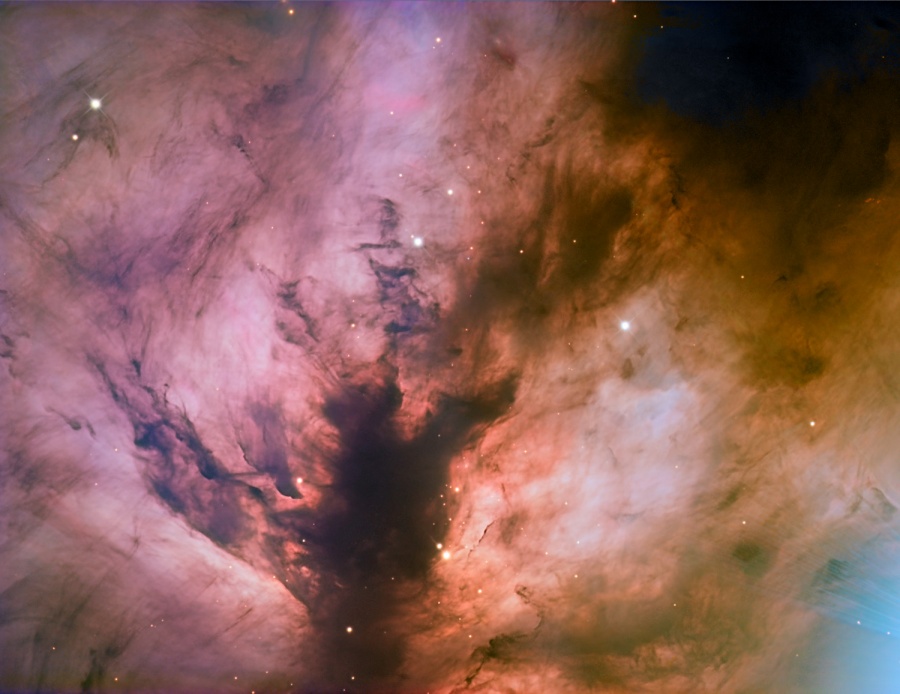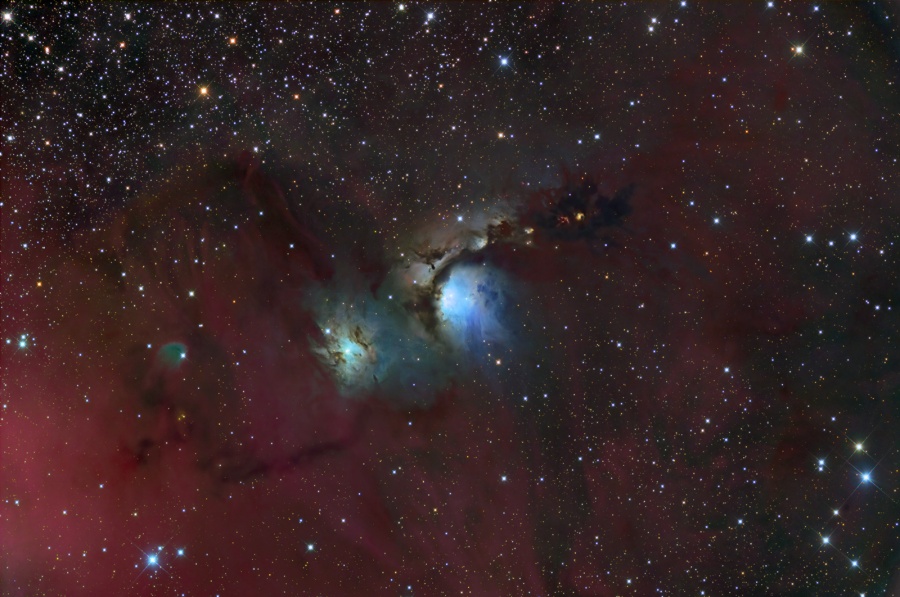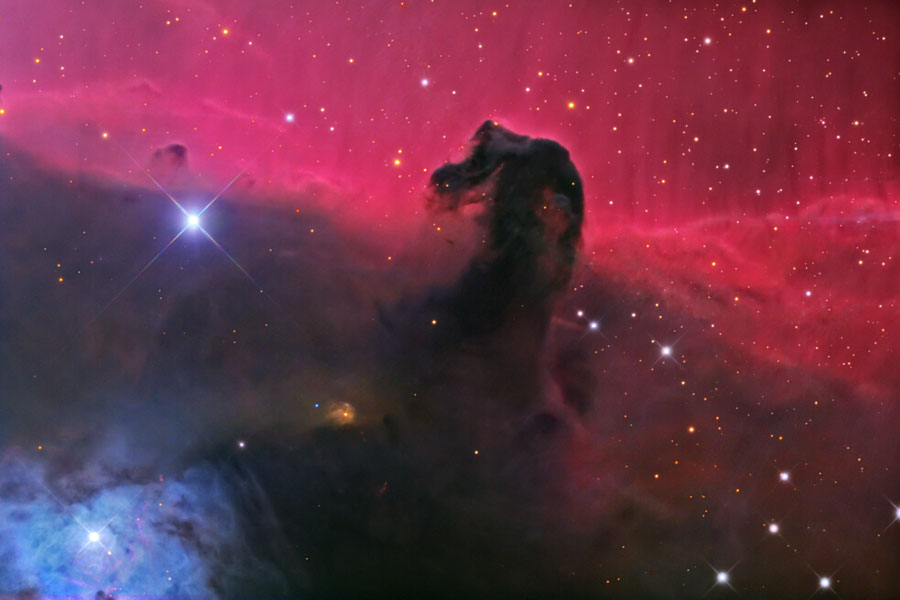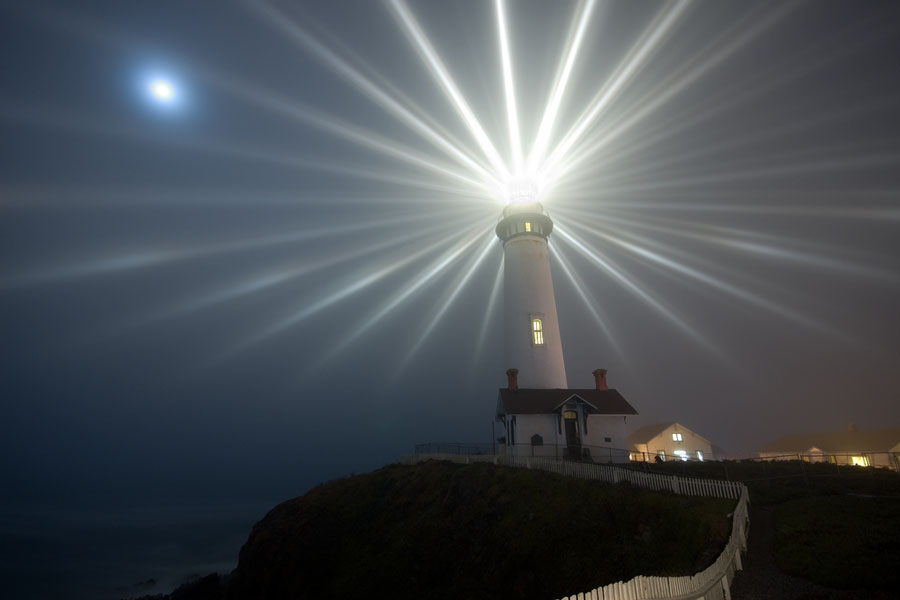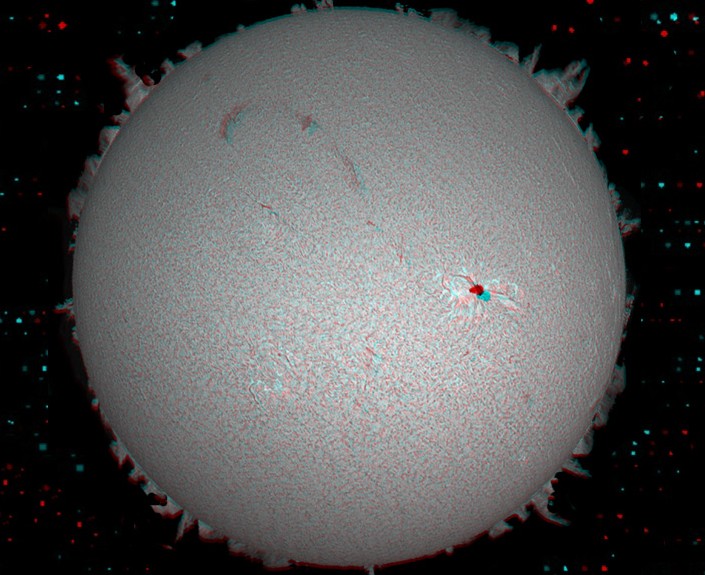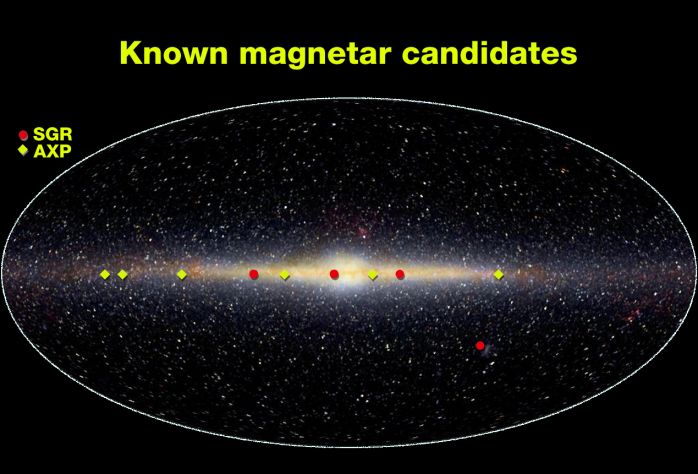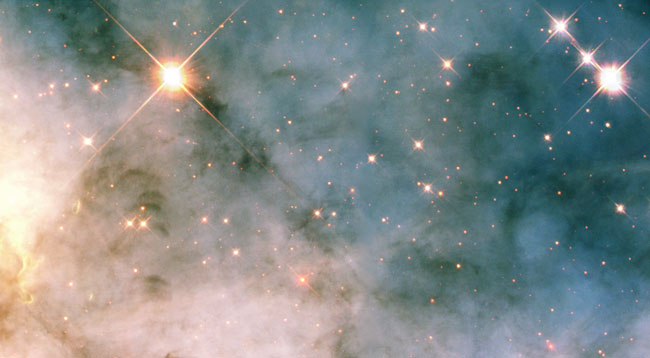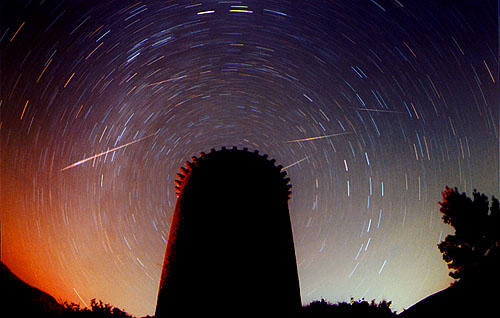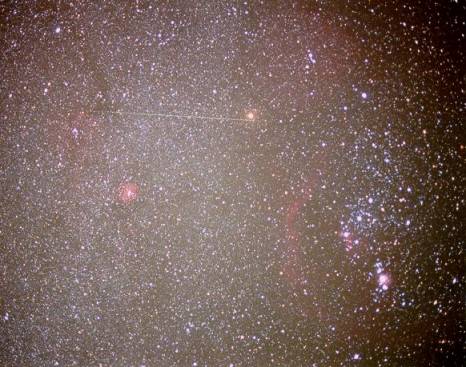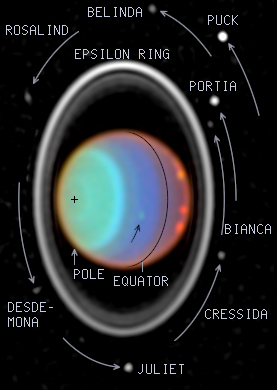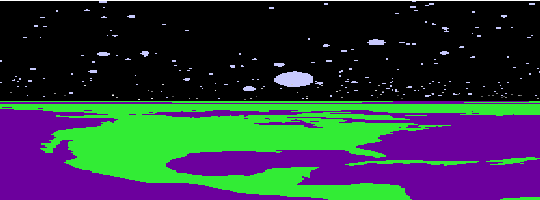| << Previous | Index | Next >> |
2014 A 24 minute sequence from top to bottom, this intriguing series of telescopic frames tracks the occultation of Io by Callisto, two of Jupiter's Galilean moons, from San Pietro Polesine, Italy, planet Earth. A challenging observational project using a small telescope, the two contrasting Jovian worlds are both slightly larger than Earth's Moon. In fact, bright, volcanic Io and dark, cratered Callisto are about 3,640 and 4,820 kilometers in diameter respectively. With Earth itself now crossing near the orbital plane of Jupiter's moons, astronomers are enjoying a season of Galilean moon mutual events ranging from eclipses to occultations. The series of orbital plane crossings produce a mutual event season every 5 to 6 years.
2013 One might say this was a bell weather day for the Sierra Nevada mountains. In January, just as the Sun was setting above the district of Albayzín in Grenada, Spain, a huge cloud appeared as a bell capping the Veleta peak. Such a Cap cloud is formed by air forced upwards by a mountain peak, with the air then cooling, saturating with moisture, and finally having its molecular water condense into cloud droplets. Such a bell-shaped cloud structure is unusual as air typically moves horizontally, making most clouds nearly flat across at the bottom. Vertical waves can also give additional lenticular cloud layers, as also seen above. Given the fleeting extent of the great cloud coupled with momentarily excellent sunset coloring, one might considered this also a bellwether day for an accomplished photographer.
2012 Wisps like this are all that remain visible of a Milky Way star. About 9,000 years ago that star exploded in a supernova leaving the Veil Nebula, also known as the Cygnus Loop. At the time, the expanding cloud was likely as bright as a crescent Moon, remaining visible for weeks to people living at the dawn of recorded history. Today, the resulting supernova remnant has faded and is now visible only through a small telescope directed toward the constellation of the Swan (Cygnus). The remaining Veil Nebula is physically huge, however, and even though it lies about 1,400 light-years distant, it covers over five times the size of the full Moon. In images like this of the complete Veil Nebula, studious readers should be able to identify several of the individual filaments. A bright wisp at the right is known as the Witch's Broom Nebula.
2011 The prominent ridge of emission featured in this vivid skyscape is designated IC 5067. Part of a larger emission nebula with a distinctive shape, popularly called The Pelican Nebula, the ridge spans about 10 light-years and follows the curve of the cosmic pelican's head and neck. The Pelican Nebula close-up was constructed from narrowband data mapping emission from sulfur, hydrogen, and oxygen atoms to red, green, and blue colors. Fantastic, dark shapes inhabiting the view are clouds of cool gas and dust sculpted by energetic radiation from young, hot, massive stars. But stars are also forming within the dark shapes. In fact, twin jets emerging from the tip of the long, dark tendril below center are the telltale signs of an embedded protostar cataloged as Herbig-Haro 555. The Pelican Nebula itself, also known as IC 5070, is about 2,000 light-years away. To find it, look northeast of bright star Deneb in the high flying constellation Cygnus.
2010 Of course, the Flame Nebula is not on fire. Also known as NGC 2024, the nebula's suggestive reddish color is due to the glow of hydrogen atoms at the edge of the giant Orion molecular cloud complex some 1,500 light-years away. The hydrogen atoms have been ionized, or stripped of their electrons, and glow as the atoms and electrons recombine. But what ionizes the hydrogen atoms? In this close-up view, the central dark lane of absorbing interstellar dust stands out in silhouette against the hydrogen glow and actually hides the true source of the Flame Nebula's energy from optical telescopes. Behind the dark lane lies a cluster of hot, young stars, seen at infrared wavelengths through the obscuring dust. A young, massive star in that cluster is the likely source of energetic ultraviolet radiation that ionizes the hydrogen gas in the Flame Nebula.
2009 Interstellar dust clouds and glowing nebulae abound in the fertile constellation of Orion. One of the brightest, M78, is centered in this colorful, wide field view, covering an area north of Orion's belt. At a distance of about 1,500 light-years, the bluish reflection nebula is around 5 light-years across. Its tint is due to dust preferentially reflecting the blue light of hot, young stars. Reflection nebula NGC 2071 is just to the left of M78. To the right of M78 and much more compact in appearance, the intriguing McNeil's Nebula is a recently recognized variable nebula associated with the formation of a sun-like star. The remarkably deep exposure also brings out the region's faint but pervasive reddish glow of atomic hydrogen gas.
2008 One of the most identifiable nebulae in the sky, the Horsehead Nebula in Orion, is part of a large, dark, molecular cloud. Also known as Barnard 33, the unusual shape was first discovered on a photographic plate in the late 1800s. The red glow originates from hydrogen gas predominantly behind the nebula, ionized by the nearby bright star Sigma Orionis. A blue reflection nebula dubbed NGC 2023 surrounds the bright star at the lower left. The darkness of the Horsehead is caused mostly by thick dust, although the lower part of the Horsehead's neck casts a shadow to the left. Streams of gas leaving the nebula are funneled by a strong magnetic field. Bright spots in the Horsehead Nebula's base are young stars just in the process of forming. Light takes about 1500 years to reach us from the Horsehead Nebula. The above image was taken earlier this month with a 0.6-meter telescope at the Mt. Lemmon SkyCenter in Arizona, USA.
2007 This spectacular sky is mostly human-made. Once a year, the Light Station at Pigeon Point near San Francisco, California, USA is lit as it was over 100 years ago. During this time, light generated by five kerosene lamps pours through 24 rotating Fresnel lenses, warning approaching ships to stay away. Early last week, light emanating from the Pigeon Point Lighthouse was particularly picturesque because of a thin fog, also blurring the distant Moon. During the latter 1970s, the lighthouse was guarded by an 800 pound pig named Lester. In modern times, the light house is still active but has been supplied with a more efficient flashing aerobeacon.
2006 Andromeda is the nearest major galaxy to our own Milky Way Galaxy. Our Galaxy is thought to look much like Andromeda. Together these two galaxies dominate the Local Group of galaxies. The diffuse light from Andromeda is caused by the hundreds of billions of stars that compose it. The several distinct stars that surround Andromeda's image are actually stars in our Galaxy that are well in front of the background object. Andromeda is frequently referred to as M31 since it is the 31st object on Messier's list of diffuse sky objects. M31 is so distant it takes about two million years for light to reach us from there. Although visible without aid, the above image of M31 is a digital mosaic of 20 frames taken with a small telescope. Much about M31 remains unknown, including how the center acquired two nuclei.
2005 A stereo view of the closest star, this creatively composited image was constructed from an extensive archive of pictures taken between March 2004 and April 2005. When viewed with red/blue glasses, the Sun's disk and surface features, including sunspots, filaments, and prominences, stand out in an exaggerated stereo perspective. The images were recorded through a narrow band hydrogen-alpha filter, designed to transmit only light from hydrogen atoms in the solar atmosphere. After combining the solar hydrogen-alpha images, a 3D star field was added to the final anaglyphic stereo view.
2004 Indicated on this infrared image of the galactic center region are positions of candidate magnetars -- believed to be the strongest magnets in the galaxy. Classified by observers as Soft Gamma Repeaters (SGRs) and Anomalous X-ray Pulsars (AXPs), these cosmic powerhouses are likely city-sized, spinning, highly-magnetized neutron stars. How strong is a magnetar's magnetic field? The Earth's magnetic field which deflects compass needles is measured to be about 1 Gauss, while the strongest fields sustainable in earthbound laboratories are about 100,000 Gauss. A magnetar's monster magnetic field is estimated to be as high as 1,000,000,000,000,000 Gauss. A magnet this strong, located at about half the distance to the Moon would easily erase your credit cards and suck pens out of your pocket. In 1998, from a distance of about 20,000 light-years, one magnetar, SGR 1900+14 generated a powerful flash of gamma-rays detected by many spacecraft. That blast of high-energy radiation is now known to have had a measurable effect on Earth's ionosphere. At the surface of the magnetar, its powerful magnetic field is thought to buckle and shift the neutron star crust generating the intense high-energy flares.
2003 How do violent stars affect their surroundings? To help find out, astronomers pointed the Hubble Space Telescope to the regions surrounding Eta Carina, a star showing signs that it may explode sometime in the next million years. The nearby nebulosity, shown above, is home to streams of hot gas, pools of cool gas, knots of dark globules, and pillars of dense dusty interstellar matter likely forming young stars. The above image explores about three light-years, a region size intermediate to the Eta Carina cocoon, which spans only about one-half of a light year, and the Great Nebula in Carina, which spans over 300 light years. In April of 1843 Eta Car briefly became second only to Sirius as the brightest star in planet Earth's night sky, even though at a distance of about 7,500 light-years, it is about 800 times farther away.
2002 NASA will launch two robots to Mars next year and you can help name them. The Mars Exploration Rovers are scheduled for launch on or near this coming June, when Mars and Earth are relatively close in their orbits. The landing craft are expected to touch down on Mars in January 2004 and deploy the robot rovers shortly thereafter. Rovers have the capability to crawl about 100 meters each day of their planned 90-day mission. The mission's scientific purpose is to seek out and inspect interesting rocks and terrain that could give clues to the past of Mars. Suggestions for names should be sent here, accompanied by a short essay, by 2003 January 31. (Eds. Note: The contest is only open to school children in grades K-12.)
2001 Sometimes you just have to stop and watch the meteors. In the early morning hours of November 18, a band of eleven people searched for a flat and cloudless site to see the 2001 Leonids Meteor Shower. Starting in central Iowa, weather satellite images indicated that southern Minnesota might be their best chance, and so off they drove. Although they couldn't shake off all of the clouds, they found a dark gravel road, pulled off, and settled in for the rare celestial light show. "By about 4 am, we were visually counting 1000 per hour. After that they started to increase dramatically." The photographer was just a little too late to catch a really bright fireball, but did catch several other bright Leonid meteors above one of the cars in the convoy. The exposure lasted a few minutes.
2000 Last year, the 1999 Leonids Meteor Shower came to a tremendous crescendo. Observers in Europe observed a sharp peak in the number of meteors visible around 0210 UTC during the early morning hours of November 18. Meteor counts then exceeded 1000 per hour - the minimum needed to define a true meteor storm. At other times and from other locations around the world, observers typically reported respectable rates of between 30 and 100 meteors per hour. This year, the 2000 Leonids were somewhat less impressive, although many astronomers hold much hope for the Leonids in 2001 and 2002. The above photograph is a 20-minute exposure ending just before the main Leonids peak of 1999 began. Visible are at least five Leonids meteors streaking high above the Torre de la Guaita, an observation tower used during the 12th century in Gorina, Spain.
1999 Glowing hot lava from the heart of Io's volcano Pele is visible in this false-color infrared composite image. It was recorded last month during the Galileo spacecraft's close flyby of the Jovian moon. Pele is near the middle of the large 1,300 kilometer diameter ring of yellowish sulfurous material deposited by its frequent volcanic plumes. The dull dark red spot on Pele itself corresponds to hot lava in the volcano's eruptive center. Temperatures up to 1,027 degrees Celsius (1,880 degrees Fahrenheit) have been previously measured for the lava. Galileo's close October Io flyby has revealed that the most volcanic body in the solar system is even more active than previously suspected, with more than 100 erupting volcanos. Yesterday, the spacecraft was scheduled to perform an even closer flyby of Io approaching to within 300 kilometers.
1998 The bold, bright star patterns of Orion (right) are a familiar sight to even casual skygazers. But this gorgeous color photo also features a subtler spectacle - the faint stars of the Milky Way. A broad region of the Milky Way runs vertically through the picture with the striking red Rosette Nebula in bloom left of center. Cutting across this dim, diffuse band of stars which lie along the plane of our Galaxy is a meteor streak. It seems to pass just under the red-orange giant star Betelgeuse at Orion's shoulder. Astrophotographer Jeff Medkeff recorded this and other beautiful time exposures from a dark sky countryside southeast of Sierra Vista, Arizona USA, during November's Leonid meteor shower.
1997 The giant planet Uranus is faint and featureless when viewed in visible light. But this pair of near-infrared mosaics from the Hubble Space Telescope's NICMOS camera reveals moons, rings, and clouds of this distant gas planet. The color coded images highlight different atmospheric layers - blue represents the deepest layers while the highest cloud features have a reddish tinge. Racing around the planet, high, bright clouds are seen to move substantially between the two pictures taken only ninety minutes apart. Ring systems are a common to the solar system's giant planets. Here the main Uranian ring seems to vary in width and is clearly brightest near the top. The eight specks beyond the ring system are small Uranian moons which also show counter-clockwise motion over ninety minutes as traced by the arrows on the right hand image.
1996 Tune your radio telescope to 408MHz (408 million cycles per second) and check out the Radio Sky! You should find that frequency on your dial somewhere between US broadcast television channels 13 and 14. In the 1970s large dish antennas at three radio observatories, Jodrell Bank, MPIfR, and Parkes Observatory, were used to do just that - the data were combined to map the entire sky. Near this frequency, cosmic radio waves are generated by high energy electrons spiraling along magnetic fields. In the resulting false color image, the galactic plane runs horizontally through the center, but no stars are visible. Instead, many of the bright sources near the plane are distant pulsars, star forming regions, and supernova remnants, while the grand looping structures are pieces of bubbles blown by local stellar activity. External galaxies like Centaurus A, located above the plane to the right of center, and the LMC (below and right) also shine in the radio sky.
1995 The above computer animated picture depicts how a very compact star would look to a nearby observer. The star pictured is actually more compact that any known except a black hole, so it is only hypothetical. The observer is situated at the photon sphere, where photons can orbit in a circle. To help the viewer better visualize the great distortions created by gravity, a map of the Earth was projected onto the star, and a map of the familiar night sky was projected above. From here one can either look down and see several duplicate images of the entire surface of the star, look up and see several duplicate images of the entire night sky, or look along the photon sphere and see the back of one's own head.
| << Previous | Index | Next >> |




